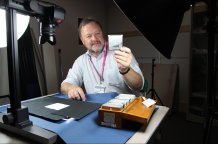
Dr Richard Crangle working in RAMM.
Unique images kept for future generations
Valuable and irreplaceable historic images will now be conserved in the UK thanks to a major European heritage project run at the University of Exeter.
Thousands of fragile and irreplaceable “magic lantern” slides will now be digitised, allowing them to be saved for future generations and made available for more people to use.
The slides were used in lantern projectors, either in private homes or at public events in churches, town halls, schools, and societies. Visiting lecturers used them as props for different purposes – as a teaching resource or during temperance or religious “shows” to encourage people to change their lifestyles. The slides show photographs of local scenes or hand painted images.
Now public money will be used on a large scale to preserve these images, allowing them to be used again in exhibitions and as a historical resource.
Exeter academics will digitise images from five museums around the country and make them available on the Lucerna Magic Lantern Web Resource open access database.
Work has already started to digitise the 5,000 slides at the Royal Albert Memorial Museum in Exeter. These slides are already being used at public events in the museum.
Dr Joe Kember, Associate Professor in Film Studies at the University of Exeter is the UK lead for the project, a partnership between the Universities of Antwerp, Exeter, Girona, Salamanca and Utrecht.
Dr Kember and his colleagues, including Dr Richard Crangle, are digitising slides at Chetham’s Library in Manchester, Manchester Museum and the Royal Geographic Society. This will allow a broad range of different images, showing social scenes as well as animals and nature, to be digitised.
Dr Kember said: “Many museums have lantern slides, some have thousands, given to them in the late 19th century and early 20th century when lanterns fell out of use. Until now it has been very difficult to know what to do with them, as they are often too fragile and difficult to use.
“The slides are a fabulous image archive and it is essential they are kept available for future generations. Digitisation means we can make these images available freely to the public. We can then run events to show the images and help museums to once again use the slides as a resource, in some instances for the first time in over a century.”
Academics from the different nations will meet at regular workshops to share information.
The project, called A Million Pictures, EURO-MAGIC, is funded by the Joint Programming Initiative on Cultural Heritage, an EU-level initiative aimed at greater coordination of research resources across member states and associated countries in order to address the particular issues affecting Europe's cultural heritage resources in times of rapidly evolving global and societal changes.
Date: 14 March 2016
